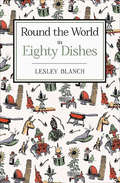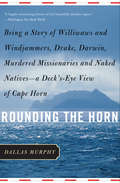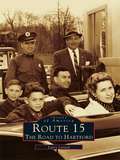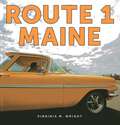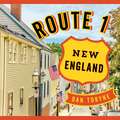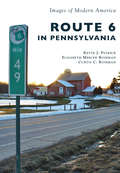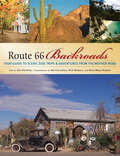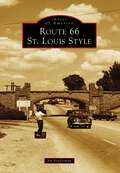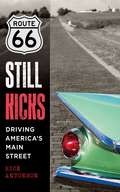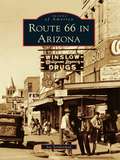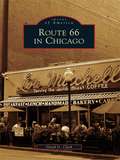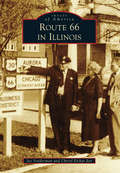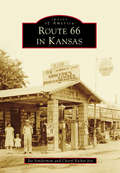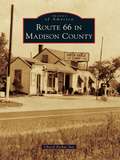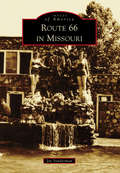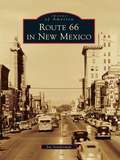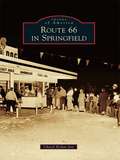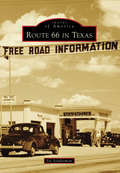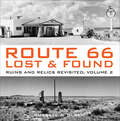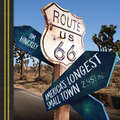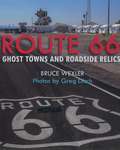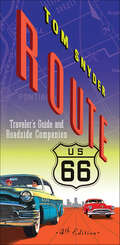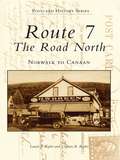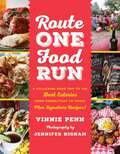- Table View
- List View
Round the World With Famous Authors
by Lowell Thomas"Round the World With Famous Authors" presents another format for a travel book -- a circumnavigation of the world through the eyes of famous writers.
Round the World in Eighty Dishes
by Lesley BlanchA grand tour for the taste buds—a delightful classic cookbook of the postwar era from a well-traveled woman. This charming little book was first published in 1956, when people in England were still enduring postwar restrictions on both traveling and eating. In the words of its author, Lesley Blanch, “benign fate whisked me elsewhere to follow less restricted ways, travelling widely and eating wildly.” Her gastronomic world tour includes eighty recipes, each prefaced by an account of where they were first tasted or with some amusing anecdote. You’ll find delicious dishes from her journeys around Europe and to the Middle East and Far East, Africa, the Pacific, Central and South America, and even a good old Baked Virginia Ham from the USA.
Rounding the Horn: Being the Story of Williwaws and Windjammers, Drake, Darwin, Murdered Missionaries and Naked Natives -- A Deck's-Eye View of Cape Horn
by Dallas MurphyFifty-five degrees 59 minutes South by 67 degrees 16 minutes West: Cape Horn--a buttressed pyramid of crumbly rock situated at the very bottom of South America--is a place of forlorn and foreboding beauty that has captured the dark imaginations of explorers and writers from Francis Drake to Joseph Conrad. For centuries, the small stretch of water between Cape Horn and the Antarctic Peninsula was the only gateway between the Atlantic and Pacific oceans. It’s a place where the storms are bigger, the winds stronger, and the seas rougher than anywhere else on earth. Dallas Murphy has always been sea-struck. In Rounding the Horn he undertakes the ultimate maritime rite of passage, and brings the reader along for a thrilling, exuberant tour. Weaving together stories of his own nautical adventures with long-lost tales of those who braved the Cape before him--from Spanish missionaries to Captain Cook--and interspersing them with breathtaking descriptions of the surrounding wilderness, Murphy has crafted an immensely enjoyable read.
Route 15: The Road to Hartford
by Larry LarnedHartford is an old New England river city separated from its eastern neighbors by the Connecticut River. With the opening of the Merritt Parkway in 1940 and construction of the Wilbur Cross Parkway inviting traffic from Boston and New York, the Connecticut legislature realized a new river bridge at Hartford would be a must for local and through traffic. This became a reality in 1942, when the Charter Oak Bridge was opened to traffic. By 1948, the system of roads and highways numbered Route 15 was completed, with Hartford as its focal point. The character of the three Connecticut parkways, the Berlin Turnpike, the Hartford Bypass, and the Charter Oak Bridge is described in Route 15: The Road to Hartford.Highway historian and retired highway engineer Larry Larned, author of Traveling the Merritt Parkway, has appeared in television and radio interviews speaking about Route 15 and the nation's early roads. Route 15: The Road to Hartford presents images from his forty years of collecting and documenting Connecticut roadside culture, architecture, and engineering. His detailed account of the road to Hartford includes personal recollections of traveling Route 15 as a youngster and studying the details along the way-the tollbooths, the bow-tied gas station attendants, the families on picnics at rest stops.
Route 1: Maine
by Down EastBased on the April 2012 issue of Down East magazine, one of our best selling issues of the year, this book is the only guide you need to the ultimate Maine road trip. Meet the people and places—and hear the stories—that make the 527 miles from Kittery to Fort Kent a unique and unforgettable experience. Plus at the back of each section get a short but sweet list of the best places to visit, stay, and eat along your way. From potato country to Down East, the Mid Coast to the Southern Beaches, Route 1 packs in everything Maine has to offer—and this book is a must-have trip companion.
Route 1: New England
by Dan TobyneStretching from end to end of the thirteen original colonies, from Fort Kent, Maine, to Key West, Florida, the connecting sections of the Atlantic Coast Highway, known as United States Route No. 1, have formed a highway of history for three hundred years. Washington traveled it repeatedly in peace and war. Now the 94-mile section between New York and Philadelphia carries a heavier average traffic than any other road of equal length in the world. Route 1 connects New York, Princeton and Philadelphia, the three cities at which the capital was established in the early years of the Republic, with Washington, the final choice; and it passes near or through nearly all of the Revolutionary battlefields and many of those of the Civil War. It grew from blazed footpaths of the settlement era to its present condition, which the Bureau of Public Roads of the United States Department of Agriculture reports as surfaced for 84 percent of the distance, graded but unsurfaced for 15 percent, and unimproved for less than 1 percent. Work is proceeding on the less improved sections. The motorist traveling the road today is reminded frequently of the life and customs of the early days by the old towns and villages through which Route 1 passes; but they also cannot miss the unique places of interest—coffee shops, gift shops, restaurants, stores, museums, parks, and scenic turnouts—to be found along its whole length. A tour down Route 1 is a trip of history and nostalgia, as well as a slice across American culture, with all its quirks and eccentricities in full bloom.
Route 6 in Pennsylvania (Images of Modern America)
by Curtis C. Roseman Elizabeth Mercer Roseman Kevin J. PatrickPennsylvania’s mid-20th-century Route 6 brought together appealing natural environments, historical events, and cultural landscapes. The eastern length of the route crosses an area featuring rolling mountains and tranquil valleys dotted by farms and towns. To the west, Route 6 traverses a more level landscape that also includes lakes. This book presents the 370-mile scenic drive as a destination in itself. It covers the secluded setting of northern Pennsylvania where Route 6 and its towns have experienced minimal changes associated with larger metropolitan regions and interstate highways. As a result, the mid-20th-century landscapes of Route 6 have lingered a little longer. The authors give the reader a peek of a past not entirely swept away.
Route 66 Backroads: Your Guide to Scenic Side Trips & Adventures from the Mother Road
by Jim HinckleyGet off the beaten path and explore the hidden-gem destinations within a few hours of the Mother Road! Includes numerous photos and illustrations.Known as the Main Street of America and the Mother Road, US Route 66 is the nation’s best-known highway. This lavishly illustrated book steers you from Chicago to Los Angeles, traveling through the lowlands of the American Plains and the high plateaus of New Mexico and Arizona, from the Great Lakes to the mighty Pacific Ocean, and through major metropolises and remote country towns.Best of all, it lets you branch away from the Mother Road and encounter gems hidden beyond today’s standard motels and tourist traps—the quaint frontier communities that date back to the nation’s westward expansion; the legacy of ancient native cultures; and the awe-inspiring natural wonders that have graced these lands since time immemorial. State parks, wildlife refuges, museums, historic sites, literary landmarks, and much more are there to be explored within a few hours’ drive from the path of Route 66. The fifty trips included here offer new travel opportunities for the thousands of road-trippers who follow this legendary route, looking for something more.“The road and this book recall a time before franchise restaurants and chain motels choked America’s highways . . . the guide consists of 50 driving tours, which include plenty of side trips.” —Arizona Republic
Route 66 St. Louis Style (Images of America)
by Joseph R. SondermanFor Route 66 to become the most famous highway in history, it had to pass through the "Gateway to the West." St. Louis is the largest city between Chicago and Los Angeles, and "St. Louee" comes first on the list of those that Nat King Cole and many other artists sang out on "(Get Your Kicks) on Route 66." The highway took a maze of different routes, including crossing the greatest of rivers on a bridge with a bend right in the middle. The roadside was lined with flashing neon, classic diners and gas stations where attendants provided speedy service. Also, there were classic amusement parks, drive-in theaters, a man selling frozen custard from a building adorned with wooden icicles, and a motel with a racy but beloved reputation. Joe Sonderman is a St. Louis area radio personality and traffic reporter who has been writing books on Route 66 for 15 years. Since that first work, he has been collecting Route 66 postcards and photographs, some never published before, along with new research on the paths Route 66 took through the area to come up with an entirely new look at Route 66 St. Louis Style .
Route 66 Still Kicks: Driving America's Main Street
by Rick Antonson"You'll never understand America until you've driven Route 66--that's old Route 66--all the way," a truck driver in California once said to author Rick Antonson. "It's the most famous highway in the world."With some determination, grit, and a good sense of direction, one can still find and drive on 90 percent of the original Route 66 today. This travelogue follows Rick and his travel companion Peter along 2,400 miles through eight states from Chicago to Los Angeles as they discover the old Route 66. With surprising and obscure stories about Route 66 personalities like Woody Guthrie, John Steinbeck, Al Capone, Salvador Dali, Dorothea Lange, Cyrus Avery (the Father of Route 66), the Harvey Girls, Mickey Mantle, and Bobby Troup (songwriter of "(Get Your Kicks on) Route 66"), Antonson's fresh perspective reads like an easy drive down a forgotten road: winding, stopping now and then to mingle with the locals and reminisce about times gone by, and then getting stuck in the mud, sucked into its charms. Rick mixes hilarious anecdotes of happenstance travel with the route's difficult history, its rise and fall in popularity, and above all, its place in legend.The author has committed part of his book's proceeds to the preservation work of the National Route 66 Federation.
Route 66 in Arizona
by Joe SondermanRoute 66 in Arizona is a ribbon tying together spectacular natural attractions such as the Grand Canyon, the Petrified Forest, the Painted Desert, and the Meteor Crater. There were plenty of man-made diversions along the way, too. Roadside businesses used Native American and Western imagery to lure travelers to fill up their gas tank, grab a meal, or spend the night. Roadside signs featured shapely cowgirls and big black jackrabbits, or warned of killer snakes and prehistoric monsters. Between wails of "Are we there yet?" children pleaded to stay at motels shaped like wigwams, explore the Apache Death Cave, or pick up a rubber tomahawk at a trading post.
Route 66 in Chicago
by David G. ClarkIt winds from Chicago to L.A."--so says Nat "King" Cole's classic hit "(Get Your Kicks on) Route 66." Beginning in 1926, Route 66 was the only U.S. highwayproviding a direct connection between the Windy City and the City of Angels; thus, it is no wonder that Route 66 would become the metaphor of the Americanjourney. The crescent-shaped route from the shore of Lake Michigan to the southern Pacific Coast followed a corridor blazed by Native American footpaths,pioneer waterways, and transcontinental railroads. As the frontier moved across the Great Plains to the ocean, Chicago was the point of embarkation for people emigrating from the east, and it was the marketplace for the products harvested in the west. During the golden age of the car culture, Chicago was where people started their California trips as they took "the highway that's the best."
Route 66 in Illinois (Images of America)
by Joe Sonderman Cheryl Eichar JettBetween the great cities of Chicago and St. Louis, there are 300 miles of adventure, history, culinary delights, and quirky attractions. This is the "Land of Lincoln" and roadside giants. There are cozy motels, cozy diners, and Cozy Dogs. Interstate 55 will speed travelers to their destination, but Route 66 offers something more. It goes through the hearts of the towns, wandering onto old brick pavement far from the roar of the interstate. Historic restaurants like Lou Mitchell's in Chicago, the Palms Grill in Atlanta, and the Ariston Cafe in Litchfield still keep their coffee pots warm. Waitresses, pump jockeys, gangsters, cops, and politicians all gave the "Main Street of America" its distinctive personality, and their stories are within these pages. So slow down, take the next exit, and head toward the beckoning neon in the distance. Come explore Route 66 in Illinois--where the road began.
Route 66 in Kansas (Images of America)
by Joe Sonderman Cheryl Eichar JettThere are only 13.2 miles of Route 66 in Kansas, but the Sunflower State packs in as much history and adventure per mile as any of the eight Route 66 states. Route 66 in Kansas includes the wild tales from the days of "Red Hot Street" and the "First Cowtown in Texas." Blood was spilled here during the Civil War and when workers in the mines fought for their rights. Travelers will meet a beloved character from the motion picture Cars, cross a rare Rainbow Bridge, and see classic scenes along the Main Streets. Kansas was completely bypassed and was not even mentioned in the Bobby Troup song "(Get Your Kicks) on Route 66," but it would be a major mistake to pass it by today. It deserves to be experienced slowly--with the top down and the radio up.
Route 66 in Madison County
by Cheryl Eichar JettRoute 66 zigzagged southwest across Madison County, Illinois, before crossing the Mississippi River into Missouri. Various alignments of this segment of the "Mother Road" rolled through pastoral farmland, headed down main streets, and later straightened as it bypassed towns. From 1926 to 1977, the path of the highway changed numerous times and crossed the Mississippi River on no less than five different bridges. Along the way motorists watched for the blue neon cross on St. Paul's Lutheran Church to guide their nighttime travel; they counted on the doors of the Tourist Haven, Cathcart's, or the Luna Café to be open for business. Travelers crossed their fingers that they wouldn't get stuck at the bend of the Chain of Rocks Bridge and hoped they could make it up Mooney Hill in the winter. A later alignment took motorists right by Fairmount Park and Monks Mound.
Route 66 in Missouri (Images of America)
by Joe SondermanRoute 66 is the "Main Street of America," heralded in song and popular culture. It took a maze of different routes through St. Louis before slashing diagonally across the "Show-Me State" through the beauty of the Ozarks. In between, there are classic motels, diners, tourist traps, and gas stations bathed in flashing and whirling neon lights. Natural wonders include crystal-clear streams, majestic bluffs, and wondrous caverns. Roadside marketers concocted legends about Jesse James, painted advertisements on barns, lived with deadly snakes, or offered curios such as pottery and handwoven baskets. That spirit is alive today at the Wagon Wheel and the Munger-Moss, the Mule, Meramec Caverns, and Ted Drewes Frozen Custard, just to name a few. Their stories are included here.
Route 66 in New Mexico
by Joe SondermanNew Mexico is "The Land of Enchantment," offering a fascinating blend of Native American, Spanish Colonial, and Western American cultures. The travelers from the East knew they had arrived in the great Southwest when they entered New Mexico--the towns along Route 66 were ablaze in neon, and the motels lured travelers with Western themes, Pueblo Revival architecture, and Native American trading posts. An adventure still awaits the traveler today who takes the time to exit I-40 and leave the franchised blandness behind. The neon still flickers at the Blue Swallow Motel in Tucumcari, on Central Avenue in Albuquerque, and at the El Rancho Hotel in Gallup. The "Fat Man" still smiles at Joseph's Bar and Grill in Santa Rosa. The stories behind those landmarks are here, as well as the stories behind establishments that are lost forever or slowly crumbling to dust among the tumbleweeds.
Route 66 in Springfield
by Cheryl JettFrom 1926 through 1977, Route 66 carried millions of travelers from the shores of Lake Michigan to the Pacific Coast. Americans fell in love with the automobile and made a family tradition of the road trip. On its three different alignments through the capital city of Springfield, Route 66 took motorists around the Illinois State Fairgrounds, past the state capitol, and through Abraham Lincoln's neighborhood. Mom-and-pop motels, gas stations, and eateries opened along the highway and became familiar landmarks to travelers in the "Land of Lincoln." In Springfield, the "horseshoe" and the "cozy dog" became popular local foods, and one of the first drive-up window restaurants opened. A man spent 40 years on Route 66 operating his gas station before transforming it into an internationally known museum. Meet the proprietors of these businesses, witness the growth of the highway, and enjoy a generous dose of nostalgia.
Route 66 in Texas
by Joe SondermanRoute 66 stretches across 178 miles and through seven counties in the Texas Panhandle. To a traveler on Interstate 40, the road may seem like an endless expanse, with the horizon interrupted only by the occasional grain elevator. But there is history, scenery, and adventure waiting on Route 66, which follows the trail of the Native Americans, conquistadors, cattle and oil barons, cowboys, and Dust Bowl refugees. With such sites as the blazing neon sign at Shamrock's U-Drop Inn and the quiet ruins of Glenrio, Route 66 in Texas is still "The Main Street of America." The traveler who leaves the franchised blandness of the interstate will see motels with Western and Native American imagery, good old-fashioned tourist traps, some bizarre sculptures (such as cars stuck in the ground at Cadillac Ranch), and beautiful Art Deco structures. These images and stories tell of mom-and-pop establishments that still thrive today and those that are crumbling in the swirling dust and tumbleweeds of the notorious Jericho Gap.
Route 66, Lost & Found: Ruins and Relics Revisited, Volume 2
by Russell A. Olsen“[The] text and photos make this . . . more than a pretty coffee-table book, Route 66 aficionados will want to add this descriptive tome to their collections.” —Ruidoso News (New Mexico)Much more than a ribbon of crumbling asphalt, Route 66 is a cultural icon revered the world over for its nostalgic value—an east-west artery pointing America toward all the promise that the great West represented. But as stretches of Steinbeck’s “Mother Road” were bypassed and fell into disuse, so too did most of the bustling establishments that had sprouted up from Illinois to California to cater to weary travelers and hopeful vacationers alike. Motor courts, cafes, main streets, filling stations, and greasy spoons—all are represented in this second volume of Lost & Found images from photographer Russell Olsen. As with its predecessor, Route 66 Lost & Found (2004), this new installment presents dozens of locations along Route 66’s entire 2,297 miles, showing them both as in their heydays in period photographs and postcards and as they appear today. Each site is accompanied by a capsule history tracing the locale’s rise and fall (and sometimes rebirth), as well as an exclusive map pointing out its location along Route 66.“Author Russell Olson has unearthed old photos and postcards of various buildings, landmarks and towns which he carefully researches and then rediscovers and takes pictures of them as they are today.” —Auto Aficionado “I could barely put this down.” —Daily Express (UK) “A good read for fans of roadside architecture.” —Classic and Sports Car (UK)
Route 66: America's Longest Small Town
by Jim HinckleyTake a road trip down the iconic &“Mother Road&”! Route 66 tells the stories of this highway's people, legends, and funky roadside attractions. Part legend, part nostalgia, part working highway, part touchstone to an America of the past, Route 66 is the only road in the United States so fascinating that both Americans and international visitors read about and may never actually travel. Route 66: America's Longest Small Town takes you on a virtual road trip, telling you about the highway's legends, stories, people, and businesses that are the essence of the Route 66 experience.You will be introduced to the road's past, present, and future, including a nostalgic look at vintage diners, signs, advertisements, and roadside attractions. Featuring all-new photography along the existing and former 2,000-mile route of the highway, this book, from America's foremost Route 66 author, combines the nostalgia of a storied past with the intriguing realities of an evolving present to create an intriguing portrait of the Mother Road of America.
Route 66: Ghost Towns and Roadside Relics
by Bruce WexlerBuckle Up and Get Your Kicks on Route 66! Originally paved in the 1920s, the 2,451 miles of Route 66 have been a staple of the American Road Trip and have become an iconic thread running through the life, history, and culture of America. Spanning a total of eight states and stretching from Chicago all the way to the Pacific Ocean, Route 66 was appropriately named the "Mother Road" by John Steinbeck. An icon of American Folklore, Route 66 details slew of old gas stations, restaurants, diners, rest stops, and other attractions. Each must-see vestige is peppered with the history of the area. Route 66: Ghost Towns and Roadside Relics takes the reader along the whole length pf the most iconic stretch of road in the world. The book brings the essence of the Mother Road to life as it swings by nostalgic towns, faded motels, vintage gas stations, dilapidated signs, and famous landmarks on the route. So buckle up and Get Your Kicks on Route 66!
Route 66: Traveler's Guide and Roadside Companion
by Tom SnyderFourth Edition —Fully revised and updated with 30 new maps throughout.Right down America's Main Street it rolled, pausing at each town along the way, then moving on, carrying travelers in search of adventure, romance, or that rare chance for a new beginning. Route 66 knew many names: the Mother Road, Will Rogers Highway, the Neon Road. And it lived up to each. Travelers met the land, found new friends—and often themselves. Now, more than a quarter-century since being officially abandoned, the old road still keeps its promise.Today, all along the highway's 2,448-mile length from Chicago to L.A., signs carrying its magic double sixes once again give direction to the journey. Yes, they assure you, this is still Route 66. . . .More than twenty years after the original publication of Route 66, this completely updated and expanded guide will make the trip along the Mother Road easier and even more exciting. Responding to requests from readers and travelers, Tom Snyder offers up-to-date routings, elegant and easy-to-read new maps, and revised information on roadside attractions. Filled with love, high jinks, and mystery, the stories Snyder narrates truly capture the flavor of the Main Street of America. Cattle rustlers, gangsters, hitchhikers, and ghosts all make appearances in these nostalgic glimpses of history-in-the-making along America's most famous highway.
Route 7, The Road North: Norwalk to Canaan
by Virginia B. Bepler Laurie J. BeplerFrom the 1890s through the 1920s, the postcard was an extraordinarily popular means of communication, and many of the postcards produced during this "golden age" can today be considered works of art. Postcard photographers traveled the length and breadth of the nation snapping photographs of busy street scenes, documenting local landmarks, and assembling crowds of local children only too happy to pose for a picture. These images, printed as postcards and sold in general stores across the country, survive as telling reminders of an important era in America's history. This fascinating new history of Route 7 from Norwalk to Canaan,Connecticut, showcases more than two hundred of the best vintage postcards available.
Route One Food Run: A Rollicking Road Trip to the Best Eateries from Connecticut to Maine
by Vinnie PennA rollicking, fast-paced tour of the best quick, indulgent, greasy, messy, delectable, and can&’t miss eats along (or not far from) Route One from Connecticut to Maine (along the 1-95 corridor). Written with acerbic wit, comedian and talk show host Vinnie Penn takes you to his favorite road trip eateries and even works his magic to persuade these places to bring some of his favorite recipes home to you. Vinnie visits over 100 places, gathers nearly 100 recipes, and packs it all alongside amusing sidebars, can&’t miss local roadside attractions and oddities, and hundreds of photos.

